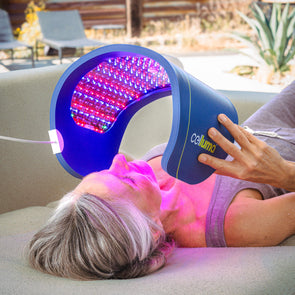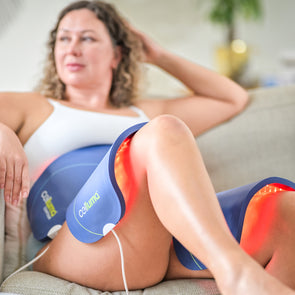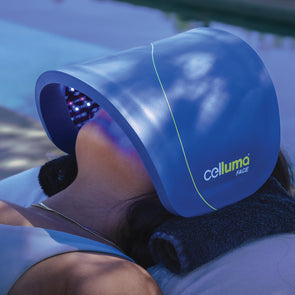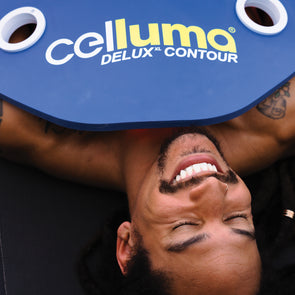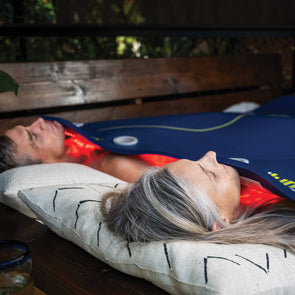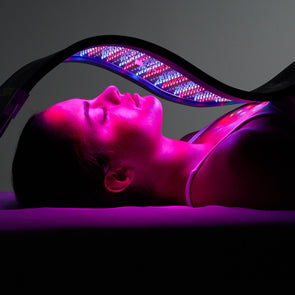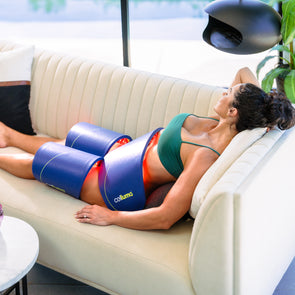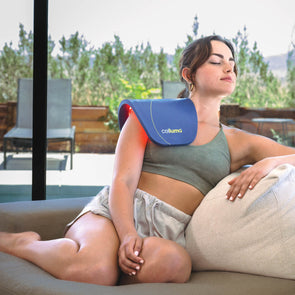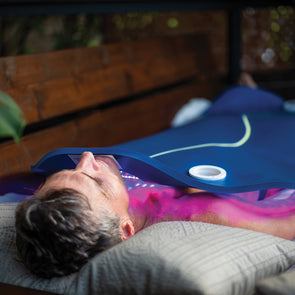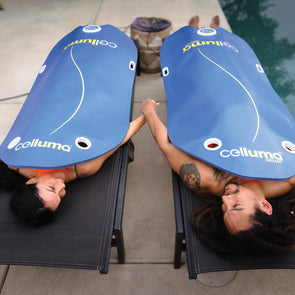NEAR INFRARED LIGHT THERAPY WITH CELLUMA
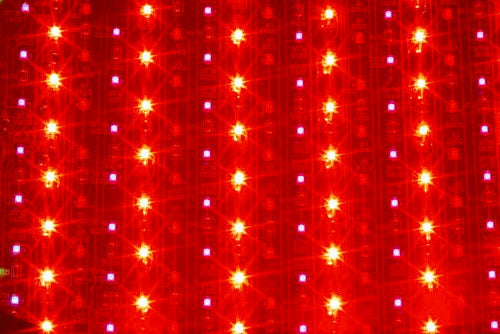
What you Need to Know About Near-Infrared Light Therapy
With various devices flooding online shopping channels and late night television, it’s time to define what LED red light therapy really is, specifically near infrared light therapy (NIR) and what it does to our bodies at the cellular level.
Infrared Light Therapy Explained
One of the easiest ways to explain infrared light therapy is to think of it as photosynthesis for mammals. Just like plants, scientific research has shown that human bodies can absorb light particles called photons and transform that light energy into adenosine triphosphate or ATP. ATP is what powers the metabolic processes in our cells, thus improving overall cellular performance and encouraging tissue repair and fosters wound healing.
What Near-Infrared Light Therapy is Not
It’s also important to understand what near infrared light therapy is not. It is not the same light used in tanning booths and it does not expose your skin to harmful UV rays. Near-infrared light therapy is also not the same as infrared saunas. Infrared used in saunas normally utilize far infrared wavelengths which emit thermal energy and have a detoxifying effect on the body. Unlike the near infrared wavelengths used in Celluma devices, longer, far-infrared wavelengths are not absorbable by the mitochondria and are therefore not capable of increasing metabolic function in compromised cells.
Red and Near-Infrared Light Therapy
Today’s LED light therapy devices use three types of wavelengths: blue, red, and near-infrared. The blue and red LED light provides great aesthetic benefits including the treatment of acne and “maskne” and increasing collagen production to help reduce those under-eye wrinkles and laugh lines as well as enhance wound closure. Near infrared provides medical benefits that are clinically proven to penetrate deep below the surface layer of the skin to better target muscle and joint pain right where it starts. This gives people much needed pain relief from inflammation and injury.
Red Light Therapy Benefits
Red and near-infrared light therapy can benefit tissue from the upper epidermal layers to deep into the dermal layer. Near-infrared light energy has the additional benefit of reaching even deeper into the subcutaneous layer where pain issues often reside. For this reason, near infrared has become known as the “pain” wavelength. Celluma light therapy devices are FDA-cleared to treat musculoskeletal conditions including muscle and joint pain, stiffness and spasm as well as the pain associated with arthritis.
The Mechanism of Action; How Red and Near Infrared Light Therapy Works
From the 2016 paper Infrared and Skin: Friend or Foe¹, published in the Journal of Photochemistry and Photobiology, written by Daniel Barolet, François Christiaens, and Michael R Hamblin.
Although skin is naturally exposed to light more than any other organ, it still responds well to red and near-infrared radiation [29]. A better understanding of the mechanism of action will direct clinicians in their treatment approach.
The cellular and molecular mechanisms of action of PBM have become reasonably well-understood in recent years and are summarized in Figure 4.
An important finding demonstrates that the NF-kB (nuclear factor-kappa B) cell signaling pathway plays an essential role thought to be activated by mitochondrial cytochrome c oxidase (COX) serving as a generator of ROS (reactive oxygen species) [40]. Changing the redox state of the mitochondrial membrane activates the formation of the transcription factor NF-kB. In the cell cytoplasm, NF-kB is inactive because it is in a complex with its specific inhibitory protein, IkB (I kappa B). ROS stimulates IkB-kinase (IkK), which triggers the phosphorylation of IkB, resulting in IkB complex decay with release of NF-kB. NF-kB is transported into the nucleus, which causes the expression of more than 150 genes many of which are involved in defense mechanisms against cell stress. The correlation between the stimulation of NF-kB and the accumulation of ROS was found in embryonic fibroblasts in vitro subsequent to their IR irradiation (810 nm). The maximal activation of NF-kB and ROS accumulation were observed at a dose of 0.3 J/cm2, while high doses caused less pronounced effects [26].
Mitochondrial ROS show a triphasic dose-response with two distinct peaks. The Janus nature of ROS is such that it may act as a beneficial signaling molecule at low concentrations and a harmful cytotoxic agent at high concentrations. This may partly explain the observed responses in vivo [26].
Near Infrared Induced Photorejuvenation
As mentioned earlier, red and near infrared have similar beneficial effects on tissue with the added benefit of near-infrared being able to reach tissue cells even deeper than red light energy.
Furthermore, in the 2016 paper “Infrared and Skin: Friend or Foe¹ by Daniel Barolet, François Christiaens and Michael Hamblin, they review the benefits of using near-infrared for skin rejuvenation. Here’s an excerpt.
Using a tissue-engineered Human Reconstructed Skin (HRS) model, it has been demonstrated that exposure to 660 nm using an irradiance of no more than 50 mW/cm2 resulted in the downregulation in MMP-1 and the upregulation of type I procollagen [18]. To correlate these results, a split-face single-blinded study was conducted which showed a significant improvement in wrinkles on 660 nm treated skin. As part of the same in vitro experiment, 805 nm (NIR) was also tested with a comparable MMP-1 decrease over 11 treatments (unpublished data) figure 3.
Lee et al. reported the effects of IR on photoaged skin [19]. Twenty patients with mild to moderate facial wrinkles received daily treatments of far infrared radiation (9-10 X 106nm ) for six months. Most patients (51-75%) reported positive improvements in skin texture and roughness. Additionally, 25-50% of patients noted fair skin tone improvement. Furthermore a prospective study showed comparable clinical results using 830 nm LEDs [20].
Histologically, a marked increase in the amount of collagen and elastic fibers in all treatment groups was observed. Ultrastructural examination demonstrated highly activated fibroblasts, surrounded by abundant elastic and collagen fibers. Immunohistochemistry showed an increase of TIMP-1 and 2. RT-PCR results showed the mRNA levels of IL-1ss, TNF-alpha, ICAM-1, and Cx43 increased after LED phototherapy whereas that of IL-6 decreased.
The Healing Power of Near Infrared
In the same paper Drs. Barolet and Hamblin go on to discuss the healing benefits of near-infrared light energy. “It has been known for almost 50 years that low energy exposure to visible and NIR wavelengths is beneficial to humans via the promotion of healing processes. This low level light therapy (so called LLLT or PBM) has been reported in thousands of peer reviewed articles since 1968 [28, 29]. Using specific low energy (non-thermal) light parameters within a window of wavelengths from visible to NIR, PBM provides an alternative therapy for patients needing faster healing of wounds and/or for anti-inflammatory purposes. It has been compared to plant photosynthesis with a known photoacceptor molecule (cytochrome c oxidase) located in the mitochondria of eucaryotic cells.
PBM parameters have been improving in the last decade so that it is now part of our therapeutic armamentarium in dermatology as a complimentary treatment modality to treat skin inflammation, promote faster wound healing after ablative procedures or even prevent sunburn [30]. It is also used as a photodynamic therapy light source to photoactivate a
Barolet et al. Page 6 J Photochem Photobiol B. Author manuscript; available in PMC 2017 February 01. Author Manuscript Author Manuscript Author Manuscript Author Manuscript
photosynthetizer (Protoporphyrin IX or PpIX) when treating actinic keratosis, basal cell carcinoma and acne [31]. Furthermore, low intensity infrared has been shown to induce beta-endorphin hypoalgesic (analgesic) effects [32].
NIR photobiomodulation of tissue pathologies is associated with increased proliferation of specific cells, gene expression of anti-inflammatory cytokines and suppression of the synthesis of pro-inflammatory mediators [33].
The Wellman Center for Photomedicine, Massachusetts General Hospital, Boston, MA 02114
Department of Dermatology, Harvard Medical School, Boston, MA 02115
Harvard-MIT Division of Health Sciences and Technology, Cambridge, MA 02139
Red Light Therapy after Strenuous Resistance Exercise: The Body Benefits

Key points found in this 2015 study from Human Performance Laboratory, University of Calgary, Alberta, Canada; the Center for Exercise Science and Department of Physical Therapy, University of Florida, Gainesville; Department of Kinesiology & Health Promotion, Troy University, Montgomery, AL, highlight the findings of what near-infrared light can do to the body and how it impacts pain relief. The study’s key points:
- Near-infrared light therapy administered before resistance exercise enhanced the contractile function of skeletal muscle by attenuating strength loss.
- Disuse atrophy and pain can be significant impediments to recovery after musculoskeletal injury. Therefore, the ability to enhance muscle function during rehabilitation is of great benefit to patients.
A Basic Breakdown of Red Light Therapy
The study gives the basic breakdown of what red light therapy actually is, stating, “Light therapy involves the application of light to a tissue to promote healing and functional recovery.1 Near-infrared (NIR) light has shown promise as a therapeutic modality for treating acute and chronic musculoskeletal injuries.1,2
Near-Infrared Light Therapy Further Explained
The authors of the study go on to explain that, “Near-infrared light modalities emit photons in a narrow bandwidth with wavelengths ranging from 700 to 1000 nm. Examples of NIR light modalities include class 3 and class 4 lasers as well as light-emitting diodes. Light-emitting diodes emit light in the red to infrared range at intensities that fall within the range of class 3 lasers. Positive therapeutic effects of light therapy are attributed to its ability to transmit photons through the skin to penetrate deeper into soft tissues, where the photons are absorbed by cellular and blood-bound proteins known as chromophores.”1
“Photon absorption by endogenous chromophores stimulates bio-chemical reactions in tissues that translate to improvements in cellular growth, repair, and function.1 This process has been referred to as photobiomodulation.” 1,3
“The majority of research conducted on NIR light therapy has focused on the ability of photostimulation to improve soft tissue healing. Investigators 4–7 have begun to explore the ergogenic effects of NIR light therapy in reducing skeletal muscle fatigue and attenuating strength loss during and after resistance exercise. Previous authors 8–10 have provided evidence for the ability of light therapy to enhance blood circulation, resulting in an increase in tissue oxygenation. Increasing circulation in the irradiated tissue can lead to enhanced oxygen and substrate delivery, thereby improving the overall ability of the muscle to perform work. An increase in oxygen delivery to the working muscle will also lead to increased adenosine triphosphate (ATP) production via aerobic respiration. With increased ATP bioavailability, the local musculature is able to perform more work and resist fatigue more readily as it limits the accumulation of metabolites and the impairment of oxygen delivery.”
“Enhancement of blood flow, oxygen delivery, and ATP synthesis within working muscle provides a physiologic basis of support for light therapy as an ergogenic aid. Any complementary therapy administered to skeletal muscle before exercise that can produce an ergogenic effect would be beneficial in rehabilitation by enhancing the target muscle’s capacity to perform work. Research has also implicated light therapy as an effective tool for enhancing skeletal muscle contractile function and for increasing the number of repetitions and the time it takes to fatigue a muscle.” 4–6,11,12
Promising Results

“Leal Junior et al12 showed a significant delay in the fatigue response to repeated electronically evoked tetanic contractions in the tibialis anterior muscles of rats exposed to light therapy. In human studies, 4–7,11 muscles exposed to laser therapy demonstrated enhanced performance by maintaining contractile force output and delaying the onset of fatigue when exposed to resistance exercise. Empirical evidence also demonstrated that light therapy can limit exercise-induced muscle damage, thereby improving biochemical and functional recovery by reducing inflammation and oxidative stress. 4,6,7,11 Therefore, the primary objective of our investigation was to evaluate the ergogenic effect of NIR light therapy on skeletal muscle function during resistance exercise for the biceps brachii muscle. We hypothesized that NIR light therapy would attenuate strength loss in the biceps brachii muscle and enhance recovery after resistance exercise by protecting the muscle from exercise-induced damage.”
In Conclusion

Once again, studies continue to show that low-level laser therapy, also known as low-level light therapy or red light therapy can reduce inflammation, promote pain relief, and help the body heal from within. Red light therapy is ideal for those looking for a drug-free treatment option.
Choose from 14 Celluma LED Light Therapy Devices
With 14 models to choose from, Celluma uses specific wavelengths of light energy to treat a variety of conditions including blue, red and near-infrared to treat acne, wrinkles, wound healing* pain and hair loss. With professional and home LED devices, you can select the LED light therapy machine that is right for you. Unlike other LED light therapy devices, Celluma is the only shape-taking LED panel on the market. It has the ability to contour close to the surface of the skin for increased light absorption and optimal therapeutic benefits. To learn more about Celluma’s near infrared technology and pain management options, click here. Treat your body right with Celluma Light Therapy!
*Celluma is not FDA-cleared for wound healing
References:
Infrared and Skin: Friend or Foe
- Daniel Barolet1,2, François Christiaens3, and Michael R Hamblin4,5,6
Department of Medicine, Dermatology Division, McGill University, Montreal, Canada H3A 1A1
RoseLab Skin Optics Laboratory, Laval, Canada, H7T 0G3
Consultant, Saint-Maur-des-Fossés, France 94100
- Near-Infrared Light Therapy to Attenuate Strength Loss After Strenuous Resistance Exercise
Kelly A. Larkin-Kaiser, PhD, CAT(C)*; Evangelos Christou, PhD†; Mark Tillman, PhD‡; Steven George, PhD, PT§; Paul A. Borsa, PhD, ATC, FACSM† *Human Performance Laboratory, University of Calgary, Alberta, Canada; †Center for Exercise Science and §Department of Physical Therapy, University of Florida, Gainesville; ‡Department of Kinesiology & Health Promotion, Troy University, Montgomery, AL


